

FROM EMBRYOLOGY TO HOMUNCULUS
Original French Edition
04/2000 French Edition
English Version (1st & 2nd Ed.)
Copyright © Dr William Theaux 1994

|
|
||

CYBEK
|
|
|
|
The following thesis has been exposed for the fisrt time in 1987 - titled The Function of the Organ [a summary can be found at Initial Fort-Da], appropriate for representing an alternative to the one of the 'orgasm' according to W.Reich; the latter being interesting yet stamped by failure. It was presented a second time in 1994 at a New-Zealand university, but get the women there upset, for it looked as re-establishing a distinction between man and woman. Some years later I present a third edition, before a public that may have evolved since. Yet it must be well informed with a phase, hardly known but important - even fundamental in order to understand the theoretical step that the text shows. That is that J.Lacan made clear that in the Freudian theory, orifices - sphincters, and not their objects - support the logic of being. Only the notion of an 'object' is given to our senses through a pass function that holes in our bodies present. Thus sphinters are organs for a topology of the mind whose premisses in Freud have been disclosed by Lacan. It is from this remarkable step of thought in our civilization that I simply draw the following conclusion: |
13/10/1994
Waikato University
Hamilton, New Zeland
by Dr. William Théaux
|
TABLE In Five Parts:
|
Let me introduce you to a wonderfull
organ, our brain.
Here it is floating [fig.1] in the liquid of the skull like a big fish, cramped
into a jar.
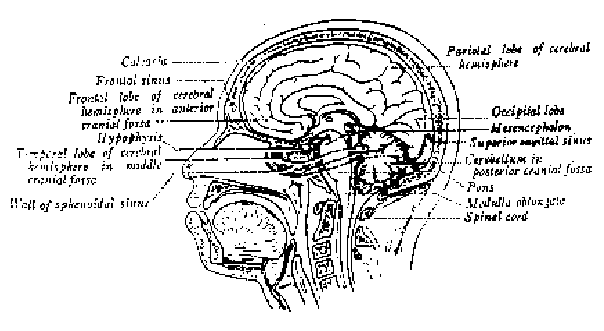 fig.1
fig.1
And here it is [fig.2] isolated so that we may examine it.
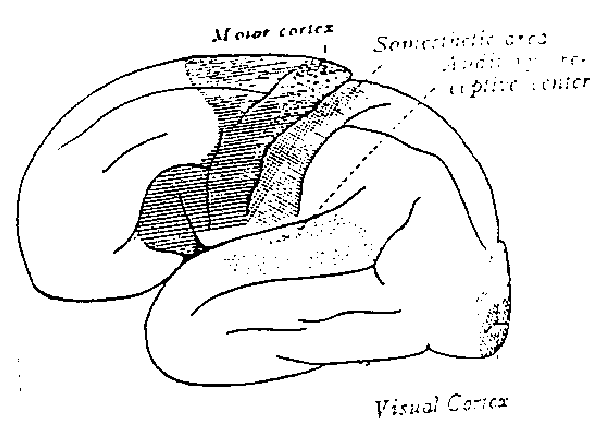 fig.2
fig.2
If we stimulate this brain point by point with an electrode, we cause movements of the body or sensations, for example of the leg, or the arm, the hand, either perceptions of sound or sight etc...
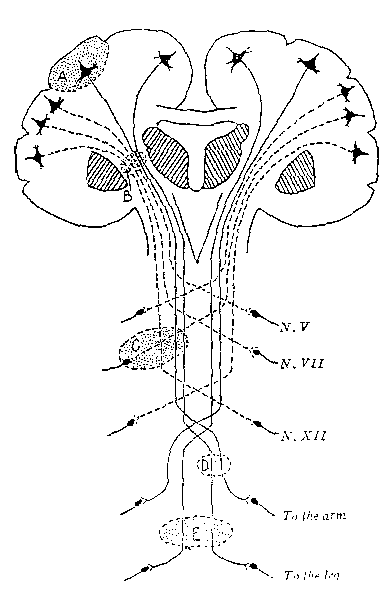
These projective effects are possible because those points on the brain are connected to the skin, the muscles or sensory organs by nerves and circuits; as shows a frontal cut [fig.3] - where you see the brain and the so called motor and sensory pathways which connect, via the spinal chord for instance the cortex (that is the superficial layer of the brain) to the arm, to the leg, etc...
That also shows how they cross, in such a way that the left part of the body is projected onto the right half of the brain - and conversely the right half of the body on the left hemi-sphere of the brain.
fig.3
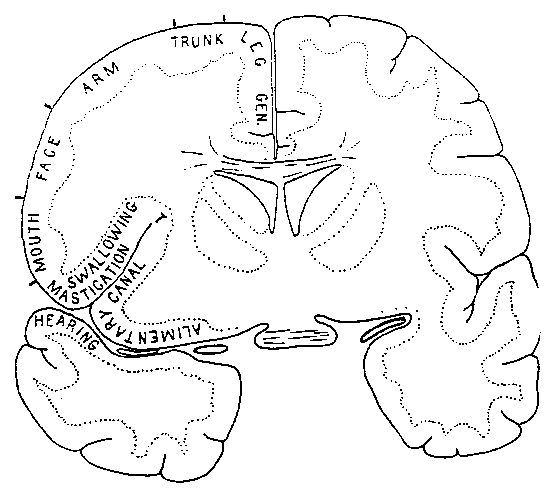
This pathway-system in charge of the whole body, connects, at the same point in every human brain, here (on this frontral-cut again[fig.4]) a leg, there the trunk, an arm, face etc...
fig.4
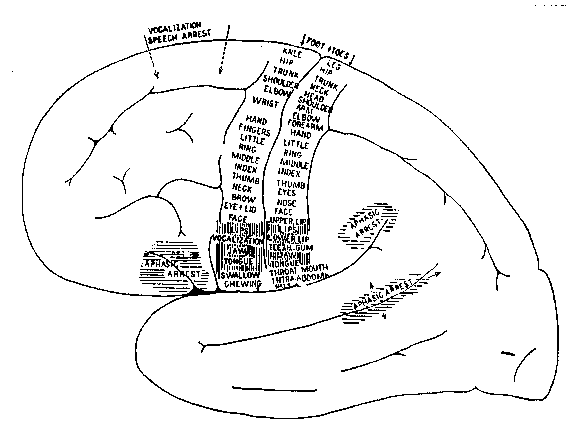
It is, so to speak, a detailed map of the body, a rich cartography, so precise (knee, hip, trunk, shoulder, elbow, wrist) that one can see it projected on the cortex [fig.5&6].
fig.5
Eventually these locations constitute a sort of corporel form called the homunculus.
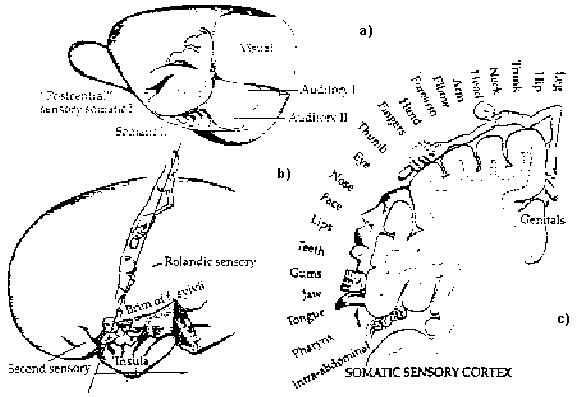 fig.6
fig.6
Here you see this vague form, on the brain of a rat [fig.6, a]; and here, on a humain brain [fig.6, b], the projected body (leg, trunk arm, hand, face), distorted but recognizable - as also here projected on the frontal cut) [fig.6, c].
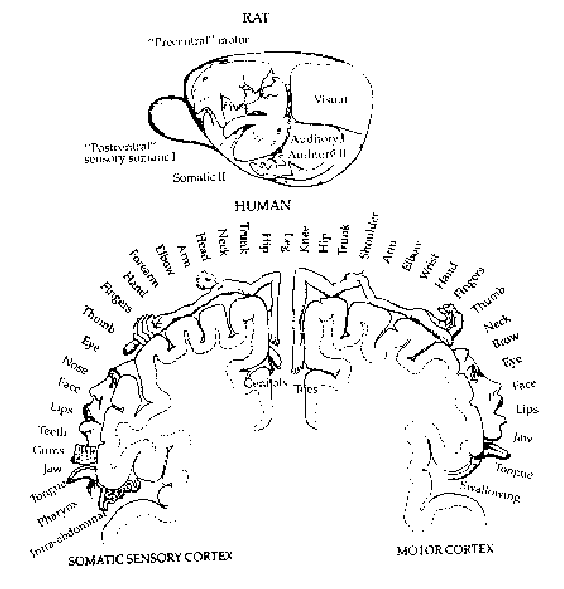
Let us be more precise:
As we firstly said [fig.3], on either side of the brain there is a homunculus
[fig.7] that represents each opposing half of the body.
fig.7
On this single hemisphere (frontal-cut [fig.8]), we see that such a map of the body presents a striking appearence, because it takes no account of the body's actual proportions, but only of the functional importance of each particular organ.
fig.8
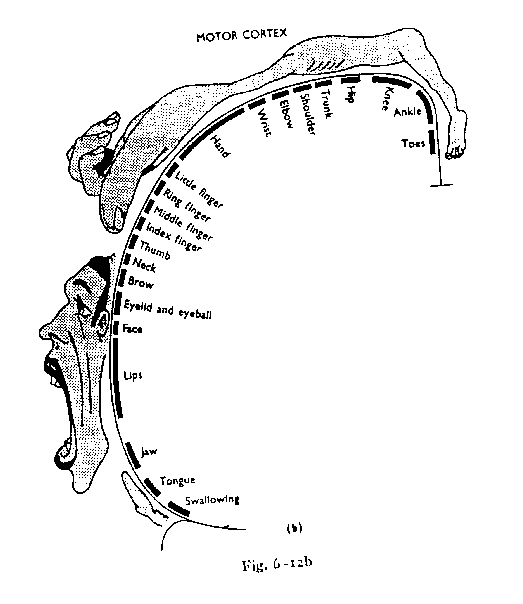
For example the thumb, because it is so intensively used, must occupy a very large place in the projection.
fig.8.bis
One calls this kind of deformation an anamorphosis.
This comical distorsion, however, must not be allowed to hide an essential issue. Like the mirror that we made you experiment with at the entrance to this lecture theatre[-Un appareil descriptible comme une lentille vide, composé de deux coups tapissées d'une paroi intérieure réfléchissante, reproduit, en un orifice supérieur, l'image réelle d'un objet déposé dans sa coupe inférieure. C'était une variation du Modèle Optique de Lacan qui était exposé à l'entrée des auditeurs de la conférence-], the cortex of the brain permits the constitution of a figure, one that is absolutely imaginary, and which Psychoanalysis calls the ego.
|
NOTE de la Première partie: |
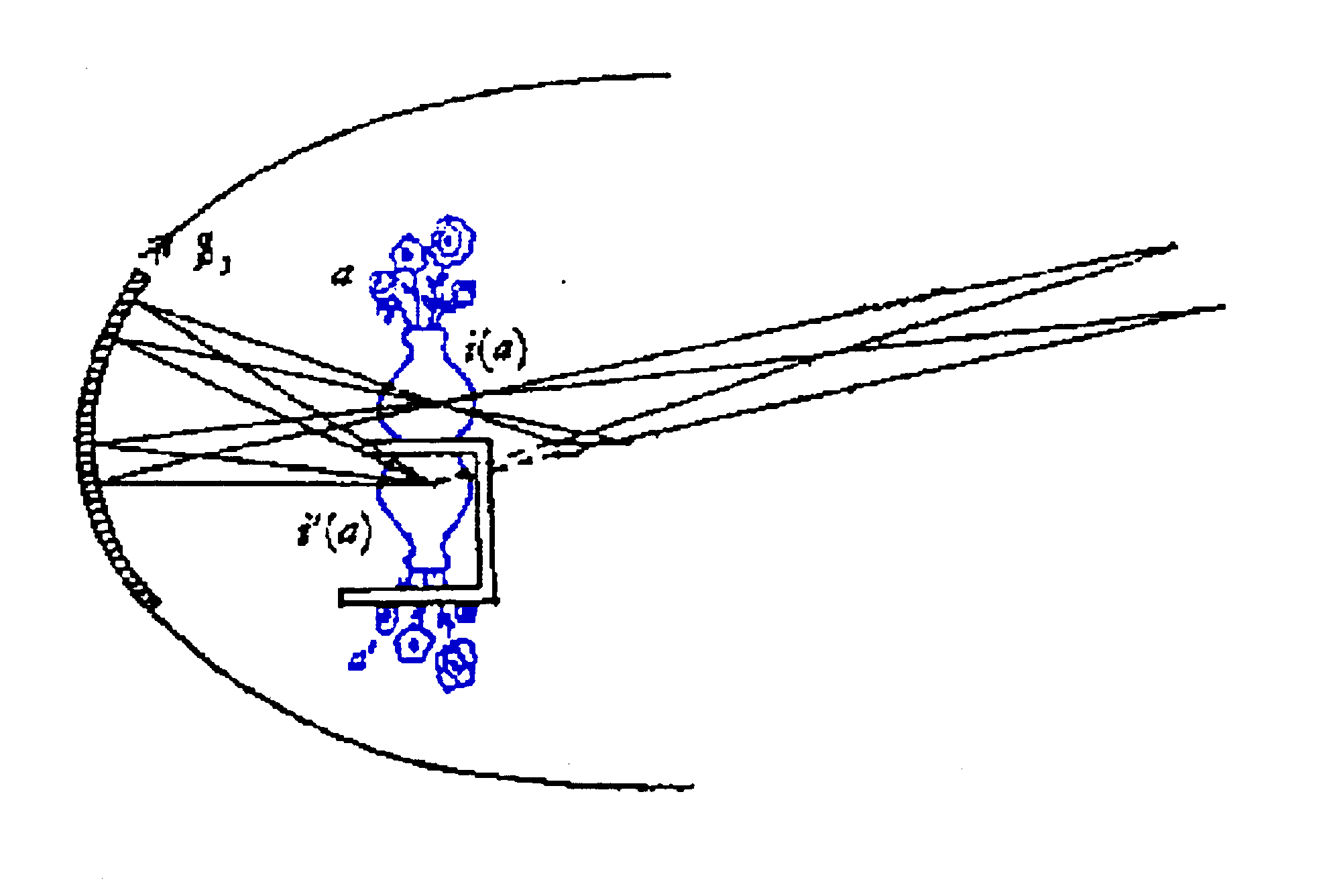
This construct has been drawn, for instance, by Jacques Lacan, the French psychiatrist & psychoanalyst; it is what he called the Optical Model. In its whole development it is a little bit more complex, but here [fig.9] it shows a concave mirror which may be compared with the cortex - and here is its inner reflexion, which constructs the ego [fig.9 blue] as the reflected carved stone that you saw floating in the air [-voir l'appareil décrit plus haut-] .
fig.9
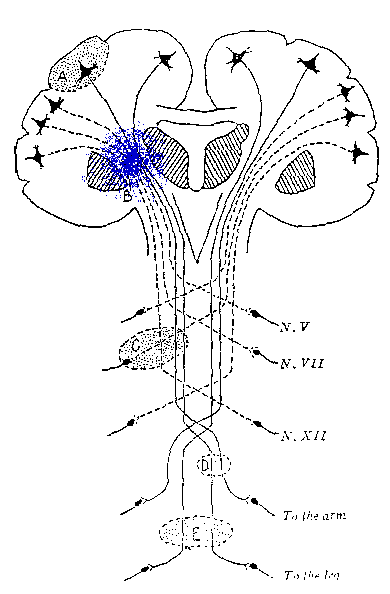
So, here is where it would be [fig.10, blue], if the brain would conjure up this image.
fig.10
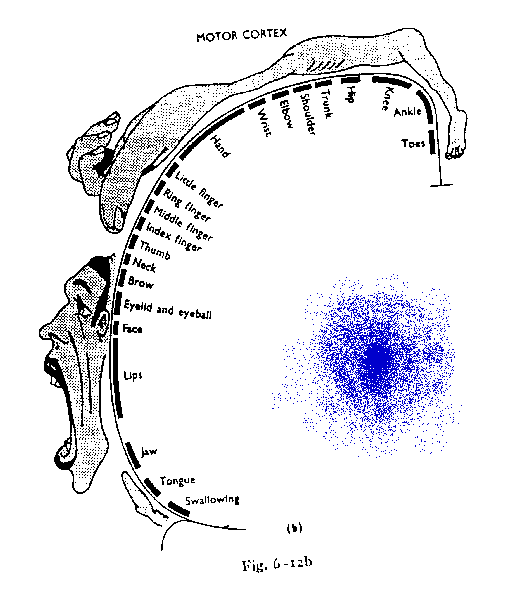
That is not to say that this ego is concrete ! In reality, it is even less concrete, of course, than the artificial mapping of the homunculus. Nevertheless it is what the Psyche takes account of. (here is where it would be again [fig.11, blue]) And because each and every one amongst us all claims that "he" or "she" exists, here is the question that it puts to us:
fig.11
|
NOTE Seconde partie: |
If this painting of MichelAngelo's [fig.12] painted on the ceiling of the Choir of the Sistine Chapel were taken to represent a humain skull & brain [-Ce qui est en fait le cas dans une thèse produite aux USA/NY, laquelle démontre une exacte superposition entre les reliefs prégrants de la représentation de Michel-Ange et une coupe anatomique cérébrale avec le pont, noyaux, etc...-] then which logic would set our dream that this phantom-ego would exert an influence on the external world?
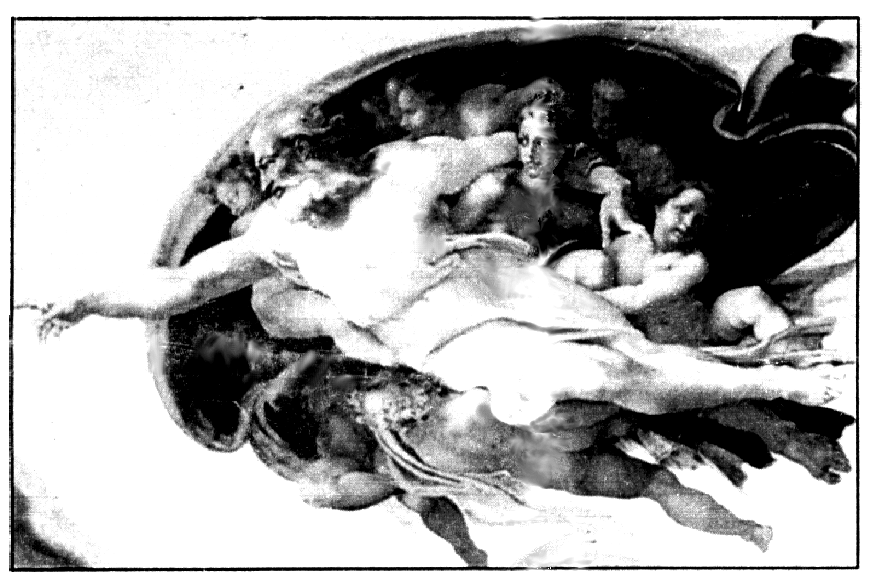
fig.12

Here is an other image [fig.13] of the ego that haunts our body; which reminds us that we fully agree with the environmentalists and other "greenies" when they say that our body has to be understood as our whole world.
And further, this ego, explorator or magician, would try to perceive the external reality through an orifice that he opens in the envelop of the body.
fig.13
Whatever the question is: how could this
imaginary ego record, project and
integrate the external product of the industrious world to its own biological
being?
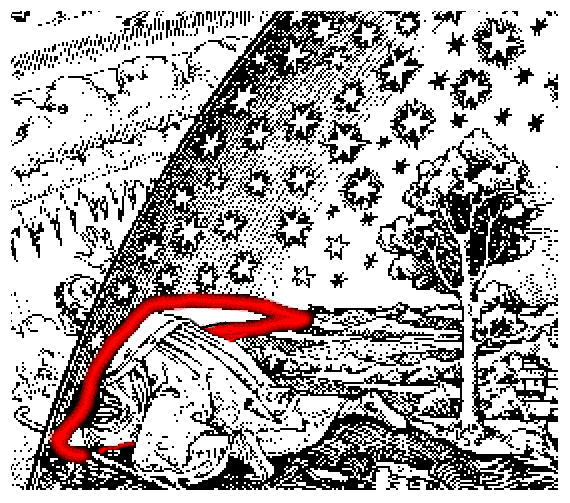
What do we know of an other object which is not attached to us by any nerves and projective path, but nonetheless often vitaly linked to the brain and its function.
Whatever it is, food, feces, or the one we love [MichelAngelo's painting], as it is libidinaly invested, there must be a way to represent the External and connect it with the neural homunculian representation.
fig.14
How does a brain know anything about a matter which does not belong to the body - and that can only be indicated by a sphincter [fig.14 red]?
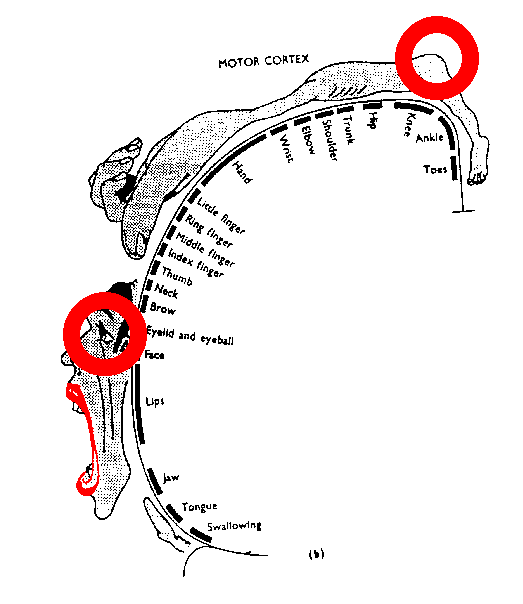
Eventualy, the only means in fact, for the brain, to integrate the external world is to employ the projection of its sphincters on the homunculus [fig.15, red] (for those through which reality passes, are connected by nerves pathways to the "brain & ego", and therefore they can be accounted as representations of the external reality).
Thus, these distinct representational points[bouche, oeil, anus] constitute the so called libidinal or erogeneous zones, which objectify the freudian Drive.
This gives the importance of the orifices (mouth, pupil, etc...) in the knowledge of our own existence.
fig.15
|
NOTE de la Troisième partie: |
Part Four : The Inguinal Orifice
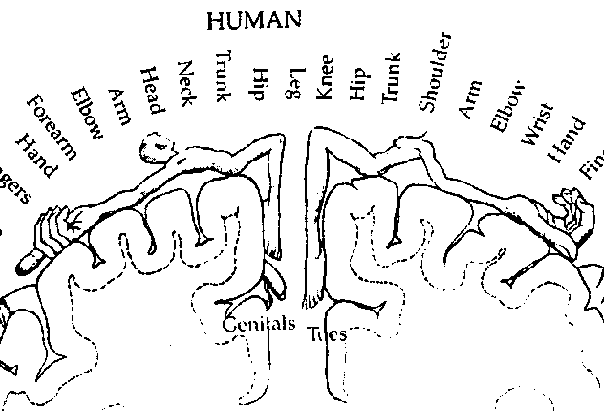
In order to understand well that the sexual difference only exists as regards to sphincters, and not as a comparison of organs, nor appendices, we can look attentively at this drawing [fig.16] - a most stupid drawing.
fig.16
It is stupid first because it starts from the good idea of the homunculus - but on this frontal cut, instead of showing left and right halves of the same organism, it shows the projection of a man on one side and of a woman on the other. It would seem to create a brain for Non-identical-Siamese-twins ! Really impossible indeed.

Further the drawing is the most stupid imaginable, because, in order to distinguish the male and the female, it shows a penis, in the very place where a feminine homunculus should display its clitoris - but it does not indicate anything here in the place of the clitoris [fig.17, red].
{it is only the leg which is there - beleive it, the artist was a foot fetichist! }. { indeed we learn about perversion ! }
fig.17
Because, by the law of deformation of proportion ruled by the foresaid "anamorphosis", the clitoris should have the same importance on the homunculus that the penis does [ - it would not be - there - an object out of place ].
Finally this drawing, by its own manifest non-sense, enables us to see what has caused this idiocy. It does not take account of the sphincters.
|
NOTE |
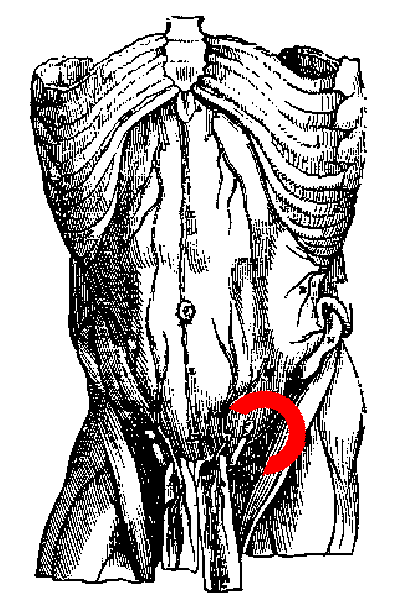
Yet, you see, there exists [fig.18, red], on male bodies only, and absolutely never on a woman's body, a certain sphincter, located on the abdominal wall (above the pubis), by which the testicles exit from the abdomen (to hang outside the body in the scrotum). It is known as the inguinal sphincter.
fig.18
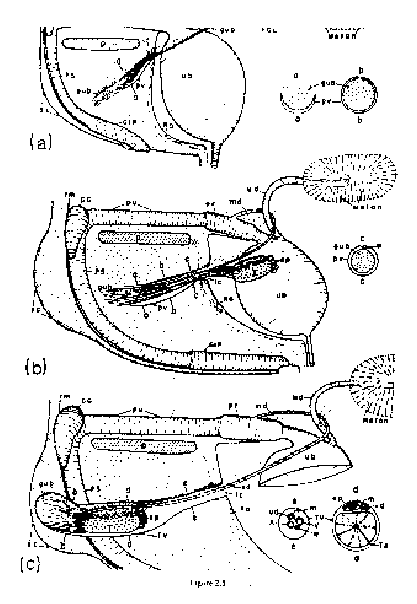
An embryological cut of the abdominal wall during the migration of testicles reveals how the testes cross the inguinal ring. (here you see - [fig.19, a),b),c)] show three stages of the embryology of the inguinal sphincter)
fig.19
Therefore, this physiology of the migrating testes projects onto the cortex of the male brain [fig.20], when he is a foetus about to be born, or at any time after his birth, (somewhere on the homunculus of a male), an image of the inguinal sphincter.
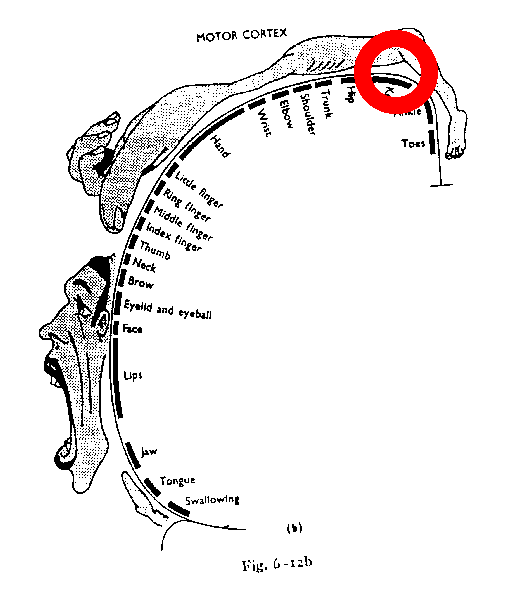
That characterizes the masculine homunculus, for it is radically different from any feature that any female homunculus ever shows.
fig.20
Moreover, that difference [fig.21] is the only one which can be probed between a male and a female brain.
fig.21
This means that human beings do not have to believe too firmly that a prick marks the distinction of the male sex. For it is a hole, an orifice that is the inguinal ring or sphincter, that characterizes its sexe.
|
NOTE concernant l'anamorphotique en général versus
l'Industrie du Code: |
Conclusion, Metapsychology
Eventually, Psychoanalysis and its misunderstandings of penis-envy, acknowledges that what one calls the Phallus signifies that the penis is the alibi for this inguinal orifice.
Let us also finally notice that this masculine hole encloses in its representation the original human genetic pool, the gonades or stump of the species. Then... the more it will be an ordinary knowledge for men and women, the more we shall enter a century that genetic experimentation inaugurates, with understanding, confidence and ability.
I thank you for your attention,
| NOTE
Une intéressante remarque a été faite, que je n'avais pas notée, à propos du dessin - fig.16. M. SCIOLINO PhD fit noter à la fin de mon exposé que l'homuncule-femme y était aussi représentée sans tête à la différence de l'homuncule-homme. Cette remarque ouvre certainement à d'intéressants développements. Pour ma part je les aurait conduits à partir de l'argument du langage, de la représentation ou de la pensée, tel qu'il compte une autre différence (cette fois-ci génésique et non pas génétique, pourrait-on dire), croisée entre l'enfant et l'adulte (que j'ai décrite, au titre du Formant).
Je ferai aussi une seconde annotation concernant la remarque «Ce n'est
pas dire que ce moi est concret ! (p.5)» S'il s'agit d'une notion
d'abstraction, je la pose, à un moment donné de l'état du discours
universitaire, voire de celui qui se réclame aujourd'hui de la science.
Plusieurs indices historiques, et logiques, laissent supposer que des
développements ultérieurs de notre perspicacité dégageront quelque
chose de connaturel à ce qu'on décrit et appelle déjà "Plasma
Magnétique" en astronomie. Pour l'instant, même si certains
appareils détectent déjà des phénomènes magnétiques dans le
cerveaux, apparemment au moins relatifs aux phénomènes de mémoire, les
signifiants de notre savoir académique ne les ont pas encore admis. je
m'en suis par conséquent tenu à estimer de telles allusions comme des
abstractions - ce qu'elles resteront peut-être toujours pour une part,
mais pour une autre part, qui seront réduites, objectivées un jour,
probablement.
Quant à la Fonction de passage
mentionnée dans la préface, il s'agit avec une
bonne probabilité d'une des notions les plus importantes, utiles,
intéressante, qui puisse influencer la science actuelle en ses nombreux
domaines (même en cosmologie par exemple). Car la Topologie introduit de
nouveaux mode de pensée, de pratique et d'application. Elle fournit par
exemple la notion de nœuds (où celle d'orifice s'inscrit
et se calcule), permettant celle de consistance
|
Éditeur MSFrontPage version 4.0.2.2717 - Écran 1024 par 768 pixels - Lecteur MS Internet Explorer Version: 5.00.2314.1003IC
L'original des images en haute qualité/définition se trouve dans le dossier intégral WTeBOOK Chap.Troudaine